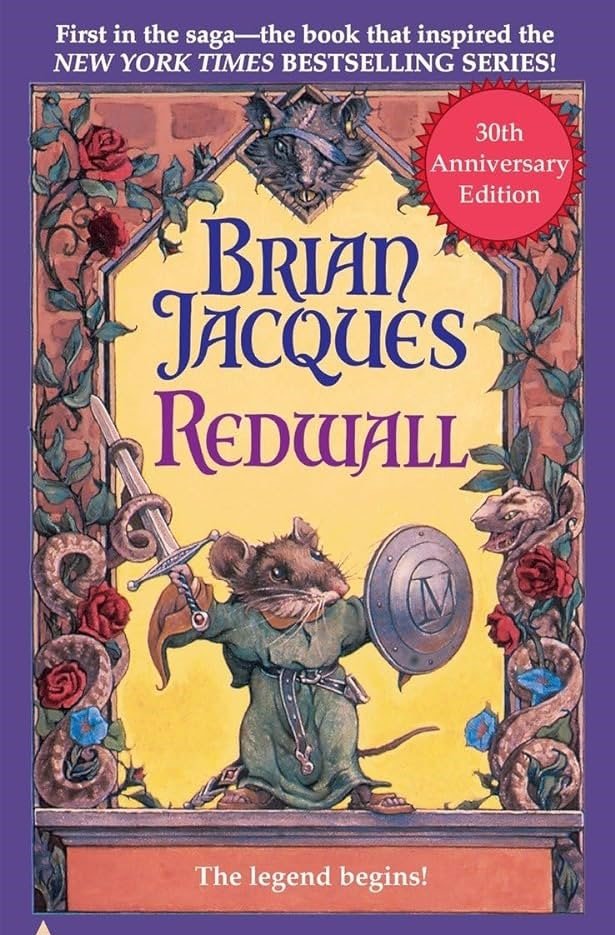In early February 2011, seventy-one-year-old Children’s Fantasy author Brian Jacques passed away. His obituary in the New York Times started out with the following description:
“He was a longshoreman and a long-haul trucker; a merchant mariner and a railway fireman; a boxer, a bus driver and a British bobby. But it wasn’t until he became a milkman that Brian Jacques found his métier. Nearing midlife, Mr. Jacques (pronounced “Jakes”) took a job driving a milk truck in Liverpool, where he was born and lived to the end of his life. On his route was the Royal School for the Blind. Invited in for a nice cup of tea one day, he volunteered to read to the students. Over time, he grew dissatisfied with the books available – too much adolescent angst, he later said – and vowed to write his own. He wrote what he called “a proper story,” brimming with battle and gallantry. Titled Redwall and published in 1986, it became the first installment in what is now a best-selling 21-volume children’s fantasy series.”
Although the covers of Jacques’ Redwall series had not seemed enticing to me as a young reader, I now found myself curious to read the stories invented by such an experienced jack-of-all-trades. A trucker/milkman/firefighter turned successful author? This didn’t fit my preconceived notion of a trucker or a milkman at all – and so this I had to see (read) for myself.
I ordered a copy of Redwall, the original book of the series, and although I thought it would probably sit on my desk for a while before I got around to reading it, I found that I was drawn to read it right away once I saw the image on the cover – an adorable little mouse clad in a green monk’s robe, fiercely wielding a sword and shield. The juxtaposition of cute and aggressive was so unexpected (and a little bit comical) that I immediately wanted to know more about the story. I was convinced simply by the picture that the mouse was sure to perform some mighty deeds.
And that is what I found in the pages of this novel – characters that exemplified this strangely heartwarming juxtaposition. Matthias the mouse and a host of others were described as adorable woodland creatures, but displayed both a traditional sense of honor and an unrelenting ferocity in defending their home against the pack of invading rats.
At first, as Cluny the Scourge and his rat army laid siege to Redwall Abbey, this concept seemed a bit ho-hum to me. There were the cute little mice, with their young and slightly awkward hero who must inevitably step up to the plate and become a Great Warrior Mouse. There was the stereotypically greedy, evil warlord who was determined to conquer the peaceable residents of the Abbey and take all the plunder for himself. There was a young female mouse who would obviously be paired with the Warrior, once he stepped into his role and achieved victory over the warlord Cluny. It all seemed a little too straightforward to me – in the beginning of the novel, that is.
But as is required for most great stories, Jacques was taking a bit of time to set up a more complex storyline. As the New York Times stated in Jacques’ obituary, the Redwall novels contain “quests and riddles; cunning treachery and chivalric derring-do,” which is a pattern that is skillfully established in the very first novel. The initial siege and battle are the catalysts that send Matthias the mouse on a quest to find Martin the Warrior’s famed sword, which he believes will assure the mice’s victory over the invading rats. The sword has changed hands several times though, and so Matthias must travel to dangerous places and befriend several groups of natural enemies before he can even locate the whereabouts of the sword, let alone regain possession of the symbolically precious weapon.
Although I still feel like the characterization of many of the animals was a little too stereotypical, the riddles and adventures in Redwall were more than enough to draw me into the novel. I was on the edge of my seat as Cluny tried plot after plot to gain access to the well-defended Abbey, and despite Jacques’ reliance on character stereotypes, I honestly even cried when one of the characters died near the end of the book. (I asked my husband if I should feel strange that I had cried while reading a book about mice and badgers and ferrets, and he just smiled at me.)
Ultimately, this novel is both adorable and engrossing because of its riddles, quests, and fairly complex (for a children’s novel) plot. I would say that Redwall falls somewhere in between C.S. Lewis’s The Chronicles of Narnia and Philip Pullman’s His Dark Materials in terms of reading level and content/complexity. I’m not convinced that the themes of Redwall are as well thought-out or developed as in either Lewis or Pullman’s work, authors who both delve into spiritual themes. In contrast, Jacques remains firmly in the territory of more simplistic platitudes, extolling peace and only advocating violence when necessary to defend your way of life. These sentiments seem pretty run of the mill when compared to Pullman’s particularly controversial themes. But while I may not have found Redwall to be quite intellectually challenging or life-changing, I can imagine that for a young(ish) child, Jacques’ novels could have quite a significant influence on their interests and literary tastes. And who can resist the moments when the mice cleverly outwit Cluny the Scourge, achieving victory after surprising victory?



This website was created with a lot of love, Coke Zero, and tacos by Kumquat Creative.